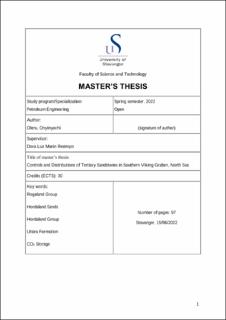| dc.description.abstract | The Tertiary succession in the Ve Sub-basin, Sleipner Terrace, Utsira High and Ling Depression is studied to understand the lateral and vertical distribution of Tertiary sandstones, to know if Tertiary tectonics had an effect on the deposition of the Tertiary sandstones and to describe the opportunities and challenges of the Tertiary sandstones for CO2 storage by using 3D seismic data and well logs.
Four intervals of interest namely Rogaland Group, Hordaland sands (named for this study), Hordaland Group and Utsira Formation are mapped and interpreted.
Tectonic uplift, sea-level fluctuations, and post-depositional processes played major roles in the lateral distribution of the Tertiary succession. The East Shetland and Scotland platforms, and the Norwegian landmass served as the source of the sediments in the Tertiary.
The faults present in the Rogaland Group showed little to no displacements. The lack of growth strata across these faults suggests that they were inactive during the deposition of the group. Late salt mobilization of the Zechstein Group created the folds in the Rogaland Group, Hordaland sands and Intra-Hordaland Group. However, the movement of the salt is suggested to have stopped after the deposition of the Hordaland sands. Polygonal faulting is mapped within the Hordaland Group and is considered mainly as seals based on recent studies and observations from this study. Mud diapirs that disrupted the lateral variation of sediments within the Hordaland Group are responsible for the multiple folds within the interval and for controlling the segmented depocenters. Thickness variations within the Utsira Formation that is caused by the underlying mud diapirs suggest that the mud diapirs were active during the deposition of the Utsira Formation.
Great opportunities exist for CO2 storage within the Tertiary succession.The Tertiary succession in this study is considered as saline aquifers due to their low resistivity values. The Utsira Formation which is currently being used for CO2 storage holds the most potential although challenges exist because of the poorly defined stratigraphic trap and the possibility of up dip migration to areas not suitable for CO2 storage. The Hordaland sands is also a promising prospect because of its thick sandy unit, good porosity and sufficient depth, however, uncertainties in the integrity of its seal and its poorly defined stratigraphic trap exists. The sandy portions of the Rogaland and Hordaland groups may also serve as potential storage sites. Several intraformational seals exist within the Tertiary succession and their presence is desirable as they cause slow migration of the CO2 which may lead to chemical trapping. | |
